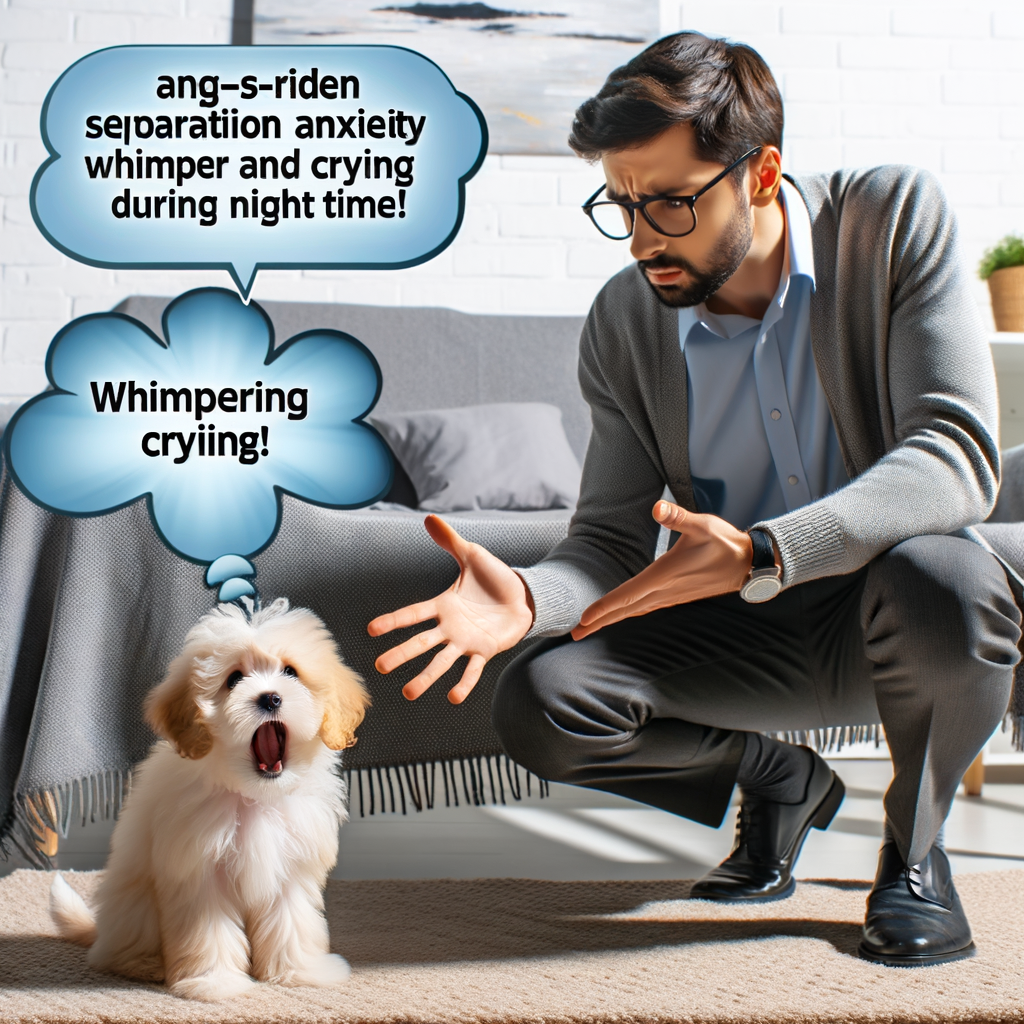
Introduction to Maltipoo Behavior Problems
Understanding your Maltipoo’s behavior is crucial to ensuring their happiness and well-being. Maltipoos, like any other breed, can exhibit certain behavior problems. This introduction will provide you with an overview of common Maltipoo behavior issues and help you understand why your Maltipoo might be acting the way they are.
- Common Maltipoo Behavior Issues
- Understanding Maltipoo Behavior
Maltipoos are generally known for their friendly and affectionate nature. However, they can also exhibit certain behavior issues. Some of the most common ones include separation anxiety, excessive whining, and crying at night. These issues can be triggered by various factors such as changes in their environment, lack of socialization, or underlying health issues.
Understanding your Maltipoo’s behavior is the first step towards addressing any issues they might be experiencing. Maltipoos are intelligent and sensitive dogs, and their behavior can often be a reflection of their emotional state. For instance, a Maltipoo that is constantly whining or crying might be feeling anxious or lonely. On the other hand, a Maltipoo that is showing signs of aggression might be feeling threatened or scared.
It’s important to remember that every Maltipoo is unique and their behavior can be influenced by a variety of factors. Therefore, it’s crucial to pay close attention to your Maltipoo’s behavior and seek professional help if necessary.
Maltipoo Separation Anxiety
Separation anxiety is a common issue among Maltipoos, a breed known for their affectionate nature and strong attachment to their owners. This section will help you identify signs of separation anxiety in your Maltipoo and provide a case study of a Maltipoo with severe separation anxiety.
Identifying Maltipoo Separation Anxiety
Recognizing the signs of separation anxiety in your Maltipoo is the first step towards addressing the issue. Here are some common signs:
- Excessive Barking or Howling: If your Maltipoo barks or howls excessively when you’re not around, it could be a sign of separation anxiety.
- Chewing, Digging, and Destruction: Maltipoos with separation anxiety often resort to destructive behaviors such as chewing on furniture or digging at doors.
- Pacing: Some Maltipoos may walk or trot along a specific path in a fixed pattern when left alone.
- Escaping: A Maltipoo suffering from separation anxiety might attempt to escape from an area where it’s confined when left alone.
Case Study: Maltipoo with Severe Separation Anxiety
Consider the case of Bella, a two-year-old Maltipoo. Bella’s owners noticed that she would become extremely anxious whenever they left the house. She would bark incessantly, chew on furniture, and even attempt to escape. Bella’s behavior escalated to the point where she would harm herself in her attempts to escape. After consulting with a veterinarian, Bella was diagnosed with severe separation anxiety. With a combination of training, medication, and a lot of patience, Bella’s owners were able to manage her anxiety and help her feel more comfortable when left alone.
Identifying the signs of separation anxiety in your Maltipoo is crucial for their wellbeing. If you notice any of these behaviors, it’s important to consult with a veterinarian or a professional dog trainer to address the issue.
Addressing Maltipoo Separation Anxiety
Separation anxiety can be a challenging issue for Maltipoos and their owners. However, with patience and the right approach, it can be managed effectively. Here, we provide a step-by-step guide and key takeaways to help you address this issue.
- Step-by-step guide to managing separation anxiety
- Understanding the Issue: The first step is to understand that your Maltipoo’s anxiety is a response to being left alone. It’s not a sign of disobedience or stubbornness.
- Gradual Desensitization: Start leaving your Maltipoo alone for short periods of time and gradually increase the duration. This helps your pet get used to being alone without feeling abandoned.
- Positive Reinforcement: Reward your Maltipoo when they remain calm as you leave and return home. This can help associate your departures and arrivals with positive experiences.
- Consistent Routine: Maltipoos thrive on routine. Keeping a consistent schedule can help reduce anxiety.
- Professional Help: If your Maltipoo’s separation anxiety is severe, consider seeking help from a professional dog trainer or a veterinary behaviorist.
- Key takeaways for dealing with Maltipoo separation anxiety
- Patience is key. It can take time for your Maltipoo to overcome separation anxiety.
- Never punish your Maltipoo for exhibiting signs of separation anxiety. This can make the problem worse.
- Ensure your Maltipoo gets plenty of exercise and mental stimulation. A tired dog is a happy dog.
- Consider using calming aids like anxiety wraps or calming diffusers for dogs.
- Always consult with a professional if you’re unsure or if the problem persists.
Let’s break down the process of managing your Maltipoo’s separation anxiety into manageable steps:
Here are some important points to remember when dealing with your Maltipoo’s separation anxiety:
Maltipoo Whining Issues
Whining is a common issue among Maltipoos. It’s important to understand why your Maltipoo may be whining and how to address it effectively.
Understanding Maltipoo Whining
Whining is a form of communication for Maltipoos. It can be a sign of various issues ranging from physical discomfort to emotional distress. Let’s delve into the reasons behind Maltipoo whining and an example of whining due to discomfort.
- Reasons behind Maltipoo whining
- Example: Maltipoo whining due to discomfort
Maltipoos may whine for a variety of reasons. These can include physical discomfort, hunger, thirst, or the need for attention. They may also whine when they are anxious or scared. It’s crucial to pay attention to the context and other signs your Maltipoo may be showing to understand the cause of the whining.
Imagine a scenario where your Maltipoo starts whining every time it tries to sit or lie down. This could be a sign of physical discomfort, possibly due to a health issue like arthritis or an injury. In such cases, it’s important to consult a vet immediately.
Understanding why your Maltipoo is whining is the first step towards addressing the issue. In the next section, we will discuss effective solutions for Maltipoo whining.
Solutions for Maltipoo Whining
Whining is a common issue among Maltipoos, but it’s not something you have to live with. There are effective methods to curb this behavior and numerous success stories to prove it. Let’s delve into some solutions.
- Effective methods to curb Maltipoo whining
- Training: Regular training sessions can help your Maltipoo understand that whining doesn’t get them what they want. Reward them when they’re quiet and ignore them when they whine.
- Exercise: Maltipoos are energetic dogs. Regular exercise can help them burn off excess energy and reduce whining.
- Comfort: Sometimes, Maltipoos whine because they’re uncomfortable. Make sure their environment is safe and comfortable.
- Attention: Maltipoos are social animals. They may whine if they feel neglected. Spend quality time with your pet every day.
- Case study: Maltipoo whining issues resolved
There are several strategies you can employ to help your Maltipoo stop whining:
Remember, consistency is key. Stick to your methods, and over time, your Maltipoo will learn to communicate without whining.
Let’s look at a real-life example of a Maltipoo owner who successfully curbed their dog’s whining.
Meet Bella, a one-year-old Maltipoo. Bella’s owner, Lisa, noticed that Bella would whine excessively, especially when left alone. Lisa decided to take action and implemented the methods mentioned above.
She started by ignoring Bella’s whining and rewarding her when she was quiet. She also ensured Bella had plenty of exercise and comfort. Over time, Bella’s whining reduced significantly.
This case study shows that with patience and consistent effort, it’s possible to curb a Maltipoo’s whining.
In conclusion, whining is a common issue in Maltipoos, but it’s not insurmountable. With the right strategies and a bit of patience, you can help your Maltipoo communicate in a healthier way.
Maltipoo Crying at Night
If you’re a Maltipoo owner, you may have experienced your furry friend crying at night. This can be a distressing situation for both you and your pet. Understanding the reasons behind this behavior can help you address it effectively.
Reasons for Maltipoo Crying at Night
There are several reasons why your Maltipoo might be crying at night. Let’s explore some of the most common causes.
- Exploring the causes of Maltipoo crying at night
- Example: Maltipoo puppy crying due to loneliness
There are several potential causes for a Maltipoo crying at night. These can include physical discomfort, such as hunger or needing to use the bathroom, or emotional distress, such as fear or anxiety. It’s important to note that each dog is unique, and what affects one Maltipoo may not affect another.
Consider the case of a Maltipoo puppy named Bella. Bella’s owners noticed that she would often cry at night, especially when left alone in her crate. After consulting with a vet, they realized that Bella was experiencing separation anxiety. She was used to being around her family all day, and being alone at night was distressing for her. This example illustrates how emotional factors can contribute to a Maltipoo crying at night.
In conclusion, understanding the reasons behind your Maltipoo’s nighttime crying can help you take steps to address the issue. Whether it’s physical discomfort or emotional distress, being aware of your Maltipoo’s needs is key to ensuring their happiness and well-being.
Addressing Maltipoo Crying at Night
It can be quite distressing to hear your Maltipoo crying at night. However, with a few practical tips and key takeaways, you can effectively handle this issue and ensure your pet’s comfort. Let’s explore these strategies.
- Practical tips to soothe a Maltipoo crying at night
- Establish a routine: Maltipoos thrive on routine. Try to feed, walk, and play with your pet at the same times every day. This can help them feel secure and reduce nighttime crying.
- Provide a comfortable sleeping area: Make sure your Maltipoo has a cozy and warm place to sleep. This can help them feel safe and reduce anxiety, which can lead to crying.
- Use calming aids: There are various calming aids available, such as anxiety wraps or calming music for dogs. These can help soothe your Maltipoo and reduce their crying at night.
- Consult a vet: If your Maltipoo’s crying persists, it’s essential to consult a vet. They can rule out any medical issues and provide further guidance.
- Key takeaways for handling Maltipoo night crying
Here are some practical steps you can take to calm your Maltipoo during the night:
When dealing with a Maltipoo crying at night, remember these key points:
| Key Takeaway | Explanation |
|---|---|
| Patience is key | It may take time for your Maltipoo to adjust to a new routine or environment. Be patient and consistent with your approach. |
| Understand the cause | Try to understand the root cause of the crying. Is it due to loneliness, anxiety, or a medical issue? Understanding the cause can help you address it effectively. |
| Seek professional help if needed | If the crying persists or if your Maltipoo seems distressed, don’t hesitate to seek help from a vet or a professional dog trainer. |
Maltipoo Emotional Health
Just like humans, Maltipoos also have emotional needs. Ensuring their emotional health is paramount to their overall well-being. Let’s delve into the importance of emotional health in Maltipoos and how you can maintain it.
Maintaining Maltipoo Emotional Health
Emotional health is a critical aspect of a Maltipoo’s life. It affects their behavior, happiness, and overall quality of life. Here’s why it’s important and a case study on improving a Maltipoo’s emotional health.
- Importance of emotional health in Maltipoos
- Case study: Improving a Maltipoo’s emotional health
Emotional health in Maltipoos is as important as their physical health. A happy and emotionally healthy Maltipoo is more likely to be active, playful, and sociable. They are less likely to develop behavioral issues such as excessive barking, chewing, or aggression. Moreover, emotionally healthy Maltipoos are easier to train and adapt better to changes in their environment.
Consider the case of Max, a two-year-old Maltipoo. Max was often left alone at home, leading to feelings of loneliness and anxiety. His owners noticed a change in his behavior – he became less active and started showing signs of depression. They decided to take action and improve Max’s emotional health.
They started by spending more time with Max, playing with him, and taking him for walks. They also introduced him to other dogs to improve his social skills. Over time, Max’s behavior improved significantly. He became more active, playful, and happier. This case study underscores the importance of maintaining a Maltipoo’s emotional health.
As a Maltipoo owner, it’s your responsibility to ensure your pet’s emotional health. Spend quality time with them, provide them with a safe and comfortable environment, and make sure they get plenty of physical exercise and mental stimulation. Remember, a happy Maltipoo is a healthy Maltipoo!
Addressing Maltipoo Sadness
It’s crucial to understand that Maltipoos, like humans, can experience a range of emotions, including sadness. This section will provide practical steps to alleviate your Maltipoo’s sadness and key takeaways for managing their emotional health.
- Steps to alleviate Maltipoo sadness
- Provide Comfort: Ensure your Maltipoo has a comfortable, safe space in your home. This could be a cozy bed or a designated area with their favorite toys.
- Regular Exercise: Regular walks and playtime can help improve your Maltipoo’s mood. Exercise stimulates the production of endorphins, the ‘feel-good’ hormones.
- Quality Time: Spend quality time with your Maltipoo. Your presence and attention can help alleviate feelings of sadness.
- Professional Help: If your Maltipoo’s sadness persists, it may be time to seek professional help. A vet or a pet behaviorist can provide guidance and treatment options.
- Key takeaways for managing Maltipoo emotional health
- Consistency is Key: Maintain a regular schedule for meals, exercise, and sleep. Consistency can provide a sense of security for your Maltipoo.
- Positive Reinforcement: Reward your Maltipoo for good behavior. This can boost their confidence and promote positive behavior.
- Monitor Changes: Keep an eye on any changes in behavior or eating habits. These could be signs of emotional distress.
- Seek Professional Advice: Don’t hesitate to seek professional advice if you’re unsure about your Maltipoo’s emotional health. Early intervention can prevent more serious issues.
Addressing your Maltipoo’s sadness begins with understanding the cause. Here are some steps you can take:
Managing your Maltipoo’s emotional health is a continuous process. Here are some key takeaways:
In conclusion, understanding and addressing your Maltipoo’s emotional health is crucial for their overall well-being. By following these steps and key takeaways, you can help ensure your Maltipoo leads a happy and healthy life.
Maltipoo Melancholy Solutions
Understanding and addressing the emotional health of your Maltipoo is crucial for their overall well-being. In this section, we will focus on identifying and addressing Maltipoo melancholy.
Identifying Maltipoo Melancholy
Before we can address melancholy in Maltipoos, it’s important to first identify the signs. Melancholy can manifest in various ways, and being aware of these signs can help you take the necessary steps to improve your pet’s emotional health.
- Signs of melancholy in Maltipoos: Maltipoos suffering from melancholy may exhibit a lack of interest in activities they once enjoyed, decreased appetite, and changes in sleep patterns. They may also appear less responsive or show less enthusiasm during playtime. It’s important to note that these signs can also be indicative of physical health issues, so it’s crucial to consult with a vet if you notice these changes.
- Example: Maltipoo showing signs of melancholy: Let’s consider the case of Bella, a normally energetic Maltipoo. Recently, her owner noticed that Bella was less interested in her daily walks and seemed to sleep more than usual. She also appeared less responsive when called. These were clear signs of melancholy, prompting Bella’s owner to seek professional help.
Identifying melancholy in your Maltipoo is the first step towards addressing it. Remember, it’s always best to consult with a professional if you notice any changes in your pet’s behavior or mood.
Addressing Maltipoo Melancholy
Addressing Maltipoo melancholy is a crucial step in ensuring your furry friend’s happiness. Let’s explore some effective strategies and a case study to better understand how to combat this issue.
- Effective strategies to combat Maltipoo melancholy
- Regular Exercise: Physical activity can help reduce feelings of sadness in your Maltipoo. Try to ensure your pet gets at least 30 minutes of exercise each day.
- Quality Time: Spending quality time with your Maltipoo can help alleviate their feelings of loneliness and sadness. This could involve playing games, grooming, or simply cuddling on the couch.
- Healthy Diet: A balanced diet can contribute to your Maltipoo’s overall mood. Ensure they’re getting the right nutrients to support their mental health.
- Professional Help: If your Maltipoo’s melancholy persists, consider seeking help from a professional dog behaviorist or a vet.
- Case study: Maltipoo melancholy successfully addressed
Addressing Maltipoo melancholy requires a comprehensive approach that includes both physical and emotional care. Here are some strategies:
Let’s look at a case study of a Maltipoo named Daisy who overcame her melancholy with the help of her loving owners and a professional dog behaviorist.
| Age | Problem | Strategy | Result |
|---|---|---|---|
| 4 years | Chronic melancholy | Regular exercise, quality time, balanced diet, and professional help | Significant improvement in mood and behavior |
Daisy’s owners noticed her persistent sadness and sought help from a professional. With a combination of regular exercise, quality time, a balanced diet, and professional guidance, Daisy’s mood improved significantly over time. This case study shows that with the right strategies and dedication, Maltipoo melancholy can be successfully addressed.
Coping with Maltipoo Distress
Dealing with a distressed Maltipoo can be challenging. However, understanding the reasons behind their distress and recognizing the signs can help you address the issue effectively.
Understanding Maltipoo Distress
Before we can help our furry friends, it’s crucial to understand what causes distress in Maltipoos and how it manifests.
- Common causes of Maltipoo distress
- Example: Maltipoo showing signs of distress
Various factors can cause distress in Maltipoos. These include changes in their environment, separation from their owners, or physical discomfort such as hunger or illness. It’s essential to monitor your Maltipoo’s behavior and environment closely to identify potential stressors.
Signs of distress in Maltipoos can vary. Some may exhibit physical symptoms like excessive panting, loss of appetite, or restlessness. Others might show behavioral changes such as increased aggression or withdrawal. For example, a normally playful Maltipoo might suddenly become quiet and unresponsive, or a usually calm Maltipoo might start barking excessively. These are clear indications that your Maltipoo might be in distress.
Understanding the causes and signs of Maltipoo distress is the first step towards helping them. In the next section, we will discuss practical ways to alleviate Maltipoo distress and ensure their emotional well-being.
Addressing Maltipoo Distress
Dealing with a distressed Maltipoo can be a challenging task. However, with the right approach and understanding, you can help your furry friend navigate through these tough times. Here are some practical tips and key takeaways to manage Maltipoo distress effectively.
- Practical tips to alleviate Maltipoo distress
- Provide a safe space: Dogs often feel distressed when they don’t have a safe and comfortable space. Create a cozy corner for your Maltipoo with their favorite toys and blankets.
- Regular exercise: Regular physical activity can help reduce anxiety and distress in Maltipoos. Ensure your pet gets enough playtime and walks.
- Consistent routine: Maltipoos thrive on routine. Feeding, walking, and playtime at regular intervals can provide a sense of security and reduce distress.
- Positive reinforcement: Reward your Maltipoo for good behavior. This can help them associate positive experiences with calm behavior.
- Key takeaways for managing Maltipoo distress
- Patience is key: It’s important to be patient with your Maltipoo. Changes won’t happen overnight, but with consistent effort, you will see improvement.
- Professional help: If your Maltipoo’s distress seems severe or persistent, don’t hesitate to seek professional help. A professional dog trainer or a vet can provide valuable insights and solutions.
- Love and care: Above all, your Maltipoo needs your love and care. Spend quality time with them, show affection, and reassure them that they are safe and loved.
Addressing your Maltipoo’s distress involves understanding their needs and responding appropriately. Here are some practical tips:
Managing Maltipoo distress is not a one-time task but a continuous process. Here are some key takeaways:
In conclusion, addressing Maltipoo distress involves understanding, patience, and consistent effort. With these practical tips and key takeaways, you can help your Maltipoo overcome distress and lead a happy, healthy life.
Conclusion: Ensuring Your Maltipoo’s Happiness
As we wrap up this informative guide, let’s take a moment to revisit the key points we’ve discussed about Maltipoo behavior problems and how to solve them. Remember, your Maltipoo’s happiness is a reflection of your care and understanding.
- Recap of Maltipoo behavior problems and solutions
- Final thoughts on maintaining Maltipoo emotional health
We’ve explored various behavior problems that Maltipoos may exhibit, such as separation anxiety, whining issues, and night crying. Each of these issues can be addressed with patience, understanding, and the right approach.
For instance, separation anxiety can be managed by gradually increasing the time you spend away from your pet, ensuring they have plenty of toys to keep them occupied, and rewarding them for calm behavior. Whining issues can be resolved by ignoring the behavior until it stops, and then rewarding your Maltipoo with attention and treats. Night crying can be minimized by establishing a consistent bedtime routine and making sure your pet has a comfortable sleeping environment.
Maintaining your Maltipoo’s emotional health is just as important as addressing their physical needs. A happy and emotionally balanced Maltipoo is a joy to be around and forms a strong bond with their human family.
Remember to provide plenty of social interaction, mental stimulation, and physical exercise for your Maltipoo. Regular vet check-ups are also essential to ensure your pet is in good health. Above all, show your Maltipoo plenty of love and affection. This will help them feel secure and loved, which is the foundation for their happiness.
In conclusion, understanding and addressing your Maltipoo’s behavior problems is key to ensuring their happiness. With patience, love, and the right approach, you can help your Maltipoo lead a happy and fulfilling life.








